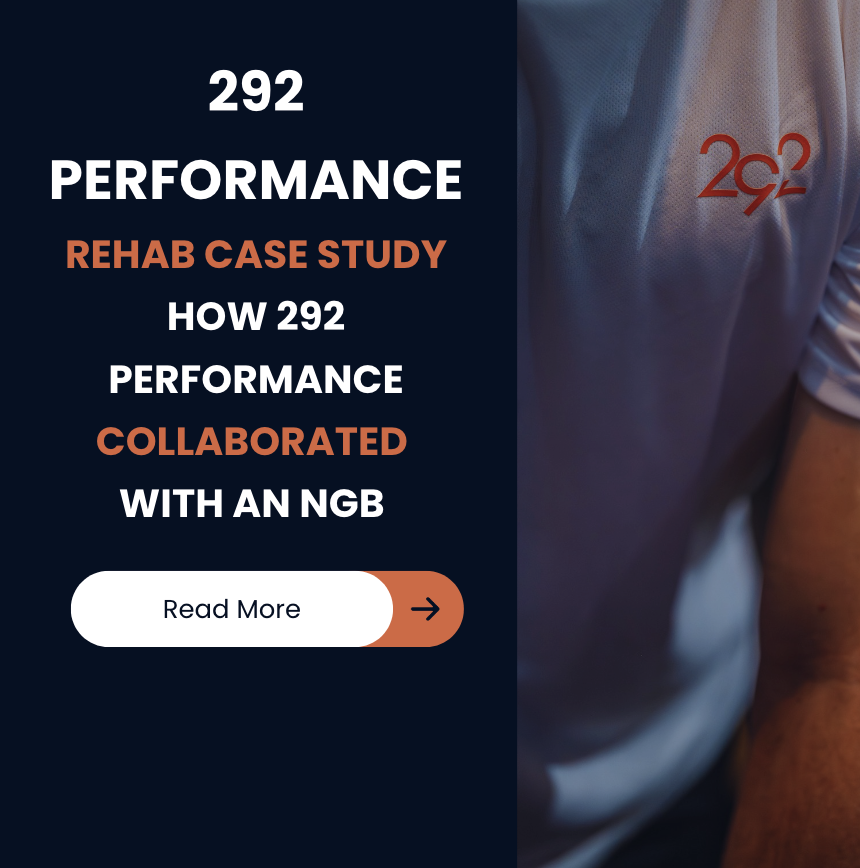292 Performance collaborated with a National Governing Body (NGB) to coordinate the rehabilitation of the left knee of an individual athlete in a team environment. One of the distinct challenges encountered during this rehabilitation process was the athlete’s continued participation in competitions across different continents.
Here’s a summary of the approach taken by 292 Performance and the results obtained
1. PERFORMANCE PLANNING
292 Performance, the NGB, the support team and the athlete spent time getting to know each other and understanding current needs, challenges and goals. There was a need for a holistic approach and high levels of communication. Knowledge, privacy, trust and communication were also key for the NGB and athlete for this particular rehabilitation.
292 Performance undertook a full profiling session including biomechanical analysis using AI technology from Speedworks and force analysis using VALD ForceDecks. Key findings were:
- Whilst sprinting, the athlete’s right leg was 25% faster off the floor and generated 7% more distance than the left leg
- The biomechanical analysis of the change of direction showed the trunk collapsed due to a lack of force production through the left side
- Reactive hop performance showed the right leg produced 20% more force than the left leg and was 25% faster
- Countermovement jump profiling discovered a lower range of movement on the left side

2. PERFORMANCE MONITORING
During this phase, 292 Performance aimed to understand how the athlete reacted to training loads and the specific work required.
After undertaking a full situation analysis, and with the help of our in-house data scientist, key performance data markers were examined. This served as the basis for providing personalised guidance to each athlete 292 performance work with. A planned out loading plan was created, communicated and shared with the NBG and athlete.

3. PERFORMANCE COACHING
The rehabilitation plan was focussed on solving the following problems:
- Knee function was currently limited by medial quad strength and calf capacity
- The result was less willingness to decelerate and take impact forces through the left leg
- This resulted in altering his change of direction biomechanics and giving irregular running patterns
The focus areas for the athlete were:
- Improving quad strength through Blood Flow Restriction (BFR) training
- Improving calf capacity through BFR training and heavy calf work
- Improve control of rotation through trunk
- Re-learn kinetic chain loading strategies through high challenge and dynamic lunge patterns, running and hurdle drills
The athlete’s rehabilitation program was integrated with their competition schedule by 292 Performance and the NGB. During the program, coaching was given in private facilities across England. Communication was maintained with the relevant stakeholders and the NGB throughout the process. When the athlete was away competing, the Physical Performance team of the NGB delivered training and coaching remotely with online consultations provided via 292 Performance
RESULTS
The athlete has since returned to full strength with no physical limitations within their sport. Implementing an individualised rehab program saw a significant performance improvement in power capacity and countermovement jump performance. The athlete can now complete single-leg jumps with no asymmetry and greater power in repeated hop performance.
FEEDBACK
Communication and collaboration are two core values of 292 Performance. Feedback from the NGB was centred around how this exceeded their expectations. The development of a strong rapport with the athlete and the utmost respect for privacy and sensitivity was commended.
For more information on how 292 Performance collaborates and provides individual external training and rehab support to athletes, clubs and NGBs, please contact us here


